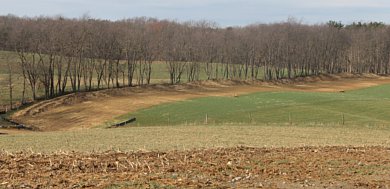Pipeline easements are the next step towards progress in the Utica shale
Thursday, March 22, 2012

CARROLLTON, Ohio — For Stanley and Diane Miller, the possibility of the construction of a pipeline across their property was the next logical step toward progress in Carroll County.
Progress
The Millers bought their farm in 1986 and began as a dairy farm. They have since stopped milking and now raise beef cattle.
They had leased their farm’s oil and gas mineral rights with Anschutz, which sold the lease to Chesapeake. They do have a vertical gas well on the property, but no horizontal drilling has occurred on the property yet.
Skip back to last May, when they found a landman at their door asking about an easement across their property for a Chesapeake pipeline.
The couple said they realized what the pipeline meant: progress for Carroll County. But then they wondered, how do they keep their farm safe?
Negotiations
At first, the couple joined a group of landowners who were also approached about the pipeline. But that, in their words, didn’t work out so they worked with their neighbor across the road (state Route 332) and had an agreement in place by September.
The pipeline, when constructed, will be 3,000 feet long across their property. It pipeline then was bored under the road and goes through their neighbor’s property. It is attached to the Burgett well and will eventually extend to the proposed refinery.
The Millers said Chesapeake worked with them on ensuring their land would be put back the way it was originally and the gas company has made sure they were content with the project.
The company wanted the project to be completed before wet weather set in, but that didn’t happen last fall.
“In a couple of weeks, we should be back together,” said Stanley.
One issue
The only complaint the Millers shared was they wished they had the final say on the placement of anything sticking above the ground. The final line has a valve sticking above the ground that will require the Millers to farm around it.
However, the Millers got a say in what will be seeded back into the ground once the work is completed.
Stanley said it should be completed in the next few weeks depending on the weather. The farm will be compensated for crop damage when the pipeline is finished.
“Everyone wants a gas well — well, this is part of it. You can’t stop progress,” said Stanley.
Stanley said once the project is completed, there will be very little that they can’t do on the land. The only limitations on the easement include constructing a septic system, no cement, and no trees can be planted. He said the property can be also used as a driveway though.
Attorney
At a Carroll County meeting March 13, Ohio Farm Bureau Energy Director Dale Arnold said the best thing anyone contemplating a pipeline easement can do is secure an attorney who knows property law and the gas industry.
Arnold said all landowners should ask what type of line — interstate, intrastate or collection line — a company wants to construct across their land.
Eminent domain could be used to get land for interstate and intrastate lines, but not usually collection lines.
Clarify one pipeline
Arnold also told the group the easement should be limited to a single pipeline and specify the pipeline pressure.
He also recommends the easement should limit the company’s rights to grant permission to add pipelines to other companies.
He suggested that some landowners could get a fee for being a “guardian of the pipeline,” which could mean a yearly income from the easement.
“You could be their first line of defense if something is going on with the pipeline,” said Arnold.
Easement prices
Many landowners in the Carroll County crowd said they are being offered $15 per linear foot for a pipeline easement, but added that amount was non-negotiable with the landmen when they were discussing easements.
Arnold advised the final agreement should include the use of the right of way for the owner and retain the rights to use the easement area for normal agricultural use. Landowners should also remember to include a requirement for reimbursement for the timber removed to build the pipeline.
Some of the key points Arnold encouraged landowners to keep in mind in negotiations is to secure a fair market value for the land, check with current land rental rates in the area, be aware of the loss of crop production and include the cost for personal attorney fees, survey work and filing fees.
* * *
Soil and Water Conservation District: How to protect your land in a pipeline easement.




